Here we are again. It’s Week 76 of the lightning attack by the Russian Army that was supposed to put Ukrainian President Volodymyr Zelensky on a one-way trip to Geneva within 72 hours. Most of the major action in the past week has been at the political level. King Mohammed bin Salman of Saudi Arabia hosted a peace conference in Jeddah to find a roadmap to ending Putin’s War in Ukraine. Ominously, all the world’s foremost economic and military powers were invited…except Russia. Russia ending the Black Sea Grain Initiative is having major blowback as the Ukrainian Navy has launched unmanned surface vehicle attacks on a Russian landing ship in port and a Russian tanker while underway. Ukraine has declared the sea lanes to Russia’s Black Sea ports as potential combat zones. We’ll see what the insurance companies think about this.
Politico-Strategic Level
China Gives Russia the Bad News
A few days ago, I posted on the Saudi-hosted peace conference in Jeddah that involved 42 nations not called Russia (Ukraine Peace Talks Move Forward With China Present and Russia Excluded). In that conference, China demonstrated that it was interested in working towards a peace plan, even if that meant throwing Russia under the bus.
"Wang told Lavrov China would 'uphold an independent and impartial stance' on Ukraine, 'actively promote' peace talks & seek a political solution."
"No limits" partnership is gone. As Russia becomes more & more isolated, China scolds it at will.
https://t.co/yVfWhO7APJ— William Courtney (@courtneywmh) August 8, 2023
This should not be a shock. Anyone who thought China was an ally of Russia must recalibrate their understanding of the situation. Russia is an erratic and undisciplined client state that can potentially drag China into a war with the West that it does not want and is not prepared for. China will look out for China, and China’s best play is to a) push the case for recognition of territorial integrity to bolster its argument for absorbing Taiwan and b) push for a new grain deal so it can claim the mantle of the hero of the Global South.
Negotiating Positions Harden
Since the Jeddah Conference, the public positions taken by Russia and Ukraine have hardened. Russia Deputy Chair of the Security Council of the Russian Federation Dmitry Medvedev had this to offer:
“Peace proposals includes the participation of both sides and this is not the case. Also Ukraine never existed until 1991, it is a fragment of the Russian empire. However, the negotiations themselves are not yet needed. The enemy must crawl on his knees, begging for mercy.”
Deputy Chair of the Security Council of the Russian Federation Dmitry Medvedev took a vodka breakfast and commented on the summit regarding Ukraine that is taking place in Jeddah.
"Peace proposals includes the participation of both sides and this is not the case. Also Ukraine… pic.twitter.com/uYXWeajVnD
— NOELREPORTS 🇪🇺 🇺🇦 (@NOELreports) August 6, 2023
Russian state television publicizes what can only be described as Moscow’s terms.
Peace Plan points by propagandist Markov.
Now he is voicing them more clearly. https://t.co/cjaoxPqpOG pic.twitter.com/kLWntKb19O
— Anton Gerashchenko (@Gerashchenko_en) August 4, 2023
Ukraine’s foreign minister has ruled out direct talks with Russia.
"We are no longer willing to negotiate directly with Putin. Crimes committed against our country are too grave for us to sit at the same table. However, mediation by 3rd parties possible, provided that Russians ready to withdraw," Ukraine's FM Kuleba says https://t.co/XIESykdUPD
— Euromaidan Press (@EuromaidanPress) August 10, 2023
Ukraine feels the political winds at its back and is giving up something Russia would never offer. Russia is acknowledging that there is no diplomatic solution that Russia can accept.
Russian Ships Damaged in Drone Attacks
Friday, a Russian landing ship was heavily damaged by a Ukrainian unmanned surface vessel (USV) attack on the Black Sea Fleet’s base at Novorossiysk; see BREAKING: Russian Navy Ship Heavily Damaged by Ukrainian Drone Strike. At the same time, a Russian-flagged freighter SIG was hit by a Ukrainian USV near Sevastopol and had to be towed into port.
🔥 Ukraine just opened a new battleground, using drones to keep Russia on its toes! A maritime drone hit a Russian military ship in Novorossiysk, and another drone took down an oil tanker near Crimea. 💣 Ukraine is sending a clear message to Moscow 👀 What comes next? pic.twitter.com/eofzlpCbLc
— Alexander the Great (@Alexander___Gr8) August 6, 2023
A damaged Russian tanker SIG from inside. The tanker reportedly got hit by an USV near thr Kerch Strait pic.twitter.com/94xSjB5c6U
— Giorgi Revishvili (@revishvilig) August 5, 2023
The Price of Indecision
In my view, this war has been unnecessarily extended by the indecision and timidity of most Western leaders. Once it became obvious that Ukraine was not going to fall to Putin’s Thunder Run on Kiev and a decision had been made to send arms to Ukraine, the Western powers should have focused on rolling the front lines back to status quo ante 2022 or status quo ante 2014 instead of engaging in onanism over finding an “off-ramp” for Putin. It was apparent even to the most casual observer that Putin had metaphorically burned his boats, and his only viable option was to double down on the war he had unleashed. Instead of decisive action focused on ending the war, the Western powers have given Ukraine modern weaponry in dribs and drabs. Eventually, Ukraine will have the arms it should’ve had over a year ago, but there is a price to be paid.
"When Ukraine first requested Western tanks, satellite images show Russia had only started to build fortifications. By time Ukraine finally received tanks, hundreds of miles of fortifications were visible." | Ukraine maps show price of allies’ hesitation https://t.co/ZzRS0ttUTH
— Peter Rough (@peterrough) August 8, 2023
Russia Strikes Strategic Ukrainian Airbase Again
The critical Ukrainian airbase at Starokostiantyniv has been hit for the second time in as many weeks (see Putin’s War, Week 74. The Crack in the Russian Wall Appears and Ben & Jerry’s Employees Join the Russian Army). This airbase is home to the Su-24 strike fighters playing hell on Russia’s rear areas with Storm Shadow/SCALP EG cruise missiles. There is no word on the damage.
A few hours after Russia launched several sustained missile attacks targeted at Starokostiantyniv Air Base, Zelensky arrives at the base and signs a SCALP EG air launched cruise missile slung under a (very much intact) SU-24M. https://t.co/HglDrctgq3
— Jimmy Rushton (@JimmySecUK) August 6, 2023
Russian Billionaire Goes Anti-War
It is something of an open secret that Russia’s elites are privately opposed to Putin’s War in Ukraine, but they are smart enough not to be vocal about it. The dam may have started breaking with billionaire Yandex founder Arkady Volozh issuing a statement criticizing the war. About 5,000 of Yandex’s employees have fled to Western Europe since the start of the war. Volozh lives in Israel. So there is a degree of “cheap grace” as Volozh is relatively safe and has waited a year and a half to make his objections known. That said, it is nearly inevitable that whatever business interests he has remained in Russia will be confiscated and anyone too closely associated with him punished.
Arkady Volozh, a Russian billionaire, the founder and, for many years, the CEO of Yandex, the Russian Google, made a clear and loud anti-war public statement today: https://t.co/tJMgebV4dA.
For years, Volozh's company was a technological pioneer in Russia and pushed forward on… pic.twitter.com/nh3hCo7ful
— Konstantin Sonin (@k_sonin) August 10, 2023
Rats From a Sinking Ship
In the days following the Russian invasion of Ukraine, European reaction went in two directions. Some countries, like Poland, immediately ceased commercial dealings. Others, like Germany, continue to have a commercial presence in Russia. A study by the Financial Times (complete article, no paywall) shows that the quicker companies exited Russia, the lower their losses. Companies with a large footprint in Russia face massive losses as they try to extricate themselves from a disaster they created.
Europe’s biggest companies have suffered at least €100bn in direct losses from 🇷🇺 operations.
"It turns out that cut and run was the best strategy for companies deciding what to do at the start of the war. The faster you left, the lower your loss.” https://t.co/1Z7e4QXN1H pic.twitter.com/vqtiGXYoRO— Dr Maria Shagina 🇺🇦 (@maria_shagina) August 6, 2023
Russia Makes Another Threat
Russian Defense Minister Sergei Shoigu lashed out at NATO support of Ukraine. He was particularly upset by the “militarization of Poland.” Because of this, Russia will reinforce the military units on the border with NATO states. (Read the article without a paywall.)
Russia Moves to Boost Army Near Europe After NATO Expansion https://t.co/hq1cHTr5UE
— sonisolan (@SoniSolan) August 9, 2023
I’m more than a little unclear on why this is supposed to frighten anyone. I don’t think there is an army north of, maybe, Niger that is afraid of the Russian military. If they were, all it would accomplish is noncombatant nations increasing their manning levels. If Shoigu is sniveling about Poland, what will he do when several other countries follow suit? Finally, the only place these reinforcements can come from is the replacement stream heading to Ukraine. But what do I know? I’m so dumb I thought invading Ukraine was a stupid idea.
Wagner Kicked Out of Belarus
In the aftermath of the failed coup by Yevgeny Prigozhin’s Wagner Group PMC (Russian Coup Update: It Ends With a Whimper as Prigozhin Goes Into Exile but Will Anything Ever Be the Same?), Wagner Group was exiled to Belarus. The purpose was to keep the fighters in Europe but out of Ukraine. In a visit to Moscow, Belarus strongman Aleksandr Lukashenko stated that the Wagner fighters wanted to invade Poland (Putin’s War, Week 74. The Crack in the Russian Wall Appears and Ben & Jerry’s Employees Join the Russian Army).
Lukashenko has now deported the Wagner fighters back to Russia. Apparently, Belarus was supposed to pick up the tab for Wagner troops in Belarus. My guess is that Lukashenko saw Wagner Group as destabilizing and unmanageable, and the last thing he needed was someone to pick a fight with a Poland that is chomping at the bit to have a go at Lukashenko and Putin.
1/ The Wagner Group is reported to have effectively been kicked out of Belarus, with thousands of its remaining fighters being bussed back into Russia. The Belarusian leader, Alexander Lukashenko, is reported to have refused to finance Wagner's stay in his country. ⬇️ pic.twitter.com/JcUJrLJiky
— ChrisO_wiki (@ChrisO_wiki) August 9, 2023
Missile Attacks on Civilians Continue
Several times a week, Russia launches missile strikes on Ukrainian cities that are not even colorable as military targets. This one is in Pokrovsk, Zaporzhzhia.
Another missile attack by russian terrorists on the civil infrastructure of Zaporizhzhia. A church, shops, and a high-rise apartment building were destroyed.
Once again, they deliberately hit a peaceful city without any military value, only to compensate for their own defeats. As… pic.twitter.com/kuh7Q4SEgW— Defense of Ukraine (@DefenceU) August 9, 2023
Taking Out the Trash
Ukraine has accelerated its anti-corruption efforts, and the war is providing excellent cover for doing so. The man arrested here is a member of Zelensky’s political party. He was arrested for taking bribes, allegedly renting public property, and pocketing money.
At this point Ukraine’s War on Corruption must be taken seriously!
The video release by NABU in conjunction with the SBU shows arrest of Servant of the People’s Rada Deputy, Anatoliy Gunko. pic.twitter.com/UFfqv92x3Y
— Sarah Ashton-Cirillo (@SarahAshtonLV) August 8, 2023
Since the start of the war in February 2022, the State Investigation Bureau of #Ukraine initiated 112 investigations against military officers in the enlistment offices (officially, Territorial Centers of Enlistment & Social Support) for bribery, illegal enrichment, physical…
— Viktor Kovalenko (@MrKovalenko) August 10, 2023
The war is giving Zelensky’s government the cover it needs to hammer official corruption because the obvious source of money is the war effort, and no one will defend people getting rich from resources that should be used to fight Russia. The effort is also critical to expedite Ukraine’s EU membership application. So while it is correct to say that Ukraine had a corruption problem last year, though not as much as Russia, Ukraine is taking steps to get its house in order. The same cannot be said of Moscow.
The Irony Continues
Under the terms of the Budapest Memorandum, Ukraine agreed to give up its nuclear weapons and sign Treaty on the Non-Proliferation of Nuclear Weapons. In return, Russia promised Ukraine that it would “refrain from threat or use of force against the territorial integrity or political independence.” Giving up nuclear weapons included giving up delivery systems such as cruise missiles and bombers. Among those systems were Kh-55 cruise missiles. Now Russia is giving them back. This a breach of two provisions of the Budapest Memorandum (those would be promises not to attack Ukraine or to use any of the surrendered weapons against it), but that has been a dead letter since 2014 when Russia invaded Donbas and annexed Crimea.
Journalists of @cxemu, an investigations project run by Svoboda, found evidence that Russia is shelling Ukraine with X-55 cruise missiles, which Ukraine handed over to Russia under the Yalta agreement in 1999.
A bit of history:
◾️ The Yalta agreement:
Valery Pustovoitenko and… pic.twitter.com/JJqqeWuDM9— Anton Gerashchenko (@Gerashchenko_en) August 5, 2023
I never cease to be amazed at the bad-faith arguments of Russian apologists who falsely claim that Russia was promised NATO would not expand as though that justified an invasion of Ukraine two decades later and manage to ignore a public document that Russia has violated.
Motherland Monument Gets a Facelift
In July, the Ukrainian government announced that it would remove the Soviet symbology from the iconic Motherland Monument that dominates Kiev’s skyline; Putin’s War, Week 72. Ukraine Misses NATO Membership but Still Wins and Ground Combat Gains Velocity. The work has been completed.
BREAKING:
The Ukrainian Trident has now replaced the communist hammer and sickle on the Motherland Monument in Kyiv.
It’s a big step forward for the decommunization process of public spaces in Ukraine and the shift in mentality it symbolizes. pic.twitter.com/kZhkrJYMZC
— Visegrád 24 (@visegrad24) August 6, 2023
As I’ve noted several times, Russia’s invasion of Ukraine has done more to develop a Ukrainian sense of national identity than anything. Ever. What Russia has done is create another Poland.
Nukes, Nukes, Nukes
One of these updates is rarely posted that someone in the comments doesn’t remind us that if we don’t mind our manners, then Putin will nuke us all. I stumbled onto this and thought I’d share it.
the evolution of global nuclear weapons, 1950-2022: pic.twitter.com/9jnpczzNpr
— ian bremmer (@ianbremmer) August 8, 2023
Great Spin
Last week, the Kingdom of Saudi Arabia hosted a 42-nation conference on ending the war in Ukraine. The US, EU, China, India, and Ukraine were there. Russia was not invited (Ukraine Peace Talks Move Forward With China Present and Russia Excluded).
This is how Russian state television handled the issue.
"Regarding the summit in Jeddah – it wasn't that we weren't invited, it was us who didn't want to come!" – Russian propagandists are trying to "save their faces" and explain to their audience why Russia wasn't there. pic.twitter.com/stmihWJiST
— Anton Gerashchenko (@Gerashchenko_en) August 8, 2023
Operational Level
Ukraine’s offensive operations continue at a slow pace on the front lines, but a strategic campaign to cut Crimea off from support is underway.
Why the Slow Ukrainian Offensive?
The topic of the relatively slow pace of the Ukrainian offensive is a constant topic. The fact is that breaching obstacles is hard work, even when you have all the tools, like total air supremacy. Ukraine is in a position where any minefield they clear can be quickly replaced via artillery-delivered mines, and supply lines you thought were secure are suddenly impassable.
— Kein Mensch Kein Tier (@KampfmitKette) August 8, 2023
In terms of this being a small world, the author was a classmate of mine at Fort Benning and gained undying fame for screaming from the depths of the Ranger School “Worm Pit,” “Mister Wizard, I don’t wanna be a Ranger anymore.”
what the typical Iraqi Obstacle belt looked like according to this. Alot more concertina wire compared to current obstacles in ukraine and no dragoon teeths but probably similar in depth and complexity https://t.co/FYJshhD9Pp pic.twitter.com/x0F5LOvnlI
— Kein Mensch Kein Tier (@KampfmitKette) August 8, 2023
The bottom line is that clearing obstacles belts it tough. It’s more challenging when your minefield lanes are being re-seeded with mines by artillery and your mine-clearing equipment is under attack by suicide drones. Maybe dismounted infantry with fixed bayonets is not a thing of the past.
New Weapons
AIM-132 ASRAAM
The AIM-132 Advanced Short Range Air-to-Air Missile (ASRAAM) is a British missile developed to replace the venerable AIM-9 Sidewinder. It travels up to 12 miles at Mach 3 and uses infrared targeting. The British are giving a ground-launched version of this weapon system to Ukraine.
The Ukrainian Armed Forces use ground launchers to launch AIM-132 ASRAAM air-to-air missiles. The information was shared by the British publication The Times. It is about homemade launchers on the basis of Supacat HMT truck.https://t.co/2EKKFxxYus
— Mats Nilsson (@mazzenilsson) August 5, 2023
It will fill a significant gap in the air defense systems of front-line units.
Combat Operations
Cluster Munitions Work
Last month, accompanied by much wailing and gnashing of teeth by arms control weenies, the US released a highly effective cluster munition called Dual Purpose Improved Conventional Munition or DPICM to Ukraine. The arms control Karens claim to oppose DPICM because its 5% or so dud rate leaves armed bomblets waiting for the careless. I think they oppose it because it is very effective, and the US version is much more effective than anything in Russia’s arsenal.
DPICM has proven its worth in combat, and it is another lesson in the folly of diplomats trying to manage the nature of war.
U.S.-made DPICM cluster-munitions are unsurprisingly performing extremely well in the type of conflict they were originally designed to be used in.
(Note that the image the WSJ chose to illustrate this article is a Russian MLRS cluster-munition carrier.)https://t.co/VHdSLRrVMi
— Jimmy Rushton (@JimmySecUK) August 8, 2023
Counterbattery Fire
Last update, I quoted a Russian milblogger talking about the genocide of Russian artillery. This is what he’s talking about. Here a Russian self-propelled gun is taking on ammunition. A Ukrainian drone detects the activity and generates a fire mission supporting artillery during the process. At 0:21, a single airburst detonates, and the fragments set a chain of explosions by ammunition and propellant.
A video of a Russian 2S19 Msta-S 152mm self-propelled howitzer being targeted by Ukrainian artillery during ammunition loading.
The strike resulted in ammunition cook-off and multiple secondaries, which ensured the destruction of both 2S19 SPG and Kamaz supply truck. pic.twitter.com/9D3gTzRns5
— Status-6 (@Archer83Able) August 7, 2023
North Korean Ammunition Appears on the Battlefield
An intricate dance has been going on between Russia and North Korea for a while. During the first November of this war, North Korea started producing uniforms for the Russian Army (Putin’s War, Week 37. Kherson Liberated and Winter Comes). Russia has tried to get ammunition from North Korea in the past, but the efforts came to nothing (Putin’s War, Week 33. Mobilization Muddle, a New Era in Air-to-Air Combat Begins, and Another Lull Before a Storm). Now we have proof that the Russian Army in Ukraine is using North Korean rocket ammunition. The images come from a Russian Telegram channel.
#Ukraine: For the first time, ammo produced by the DPRK was spotted in the hands of the Russian military- North Korean 🇰🇵 R-122 122mm rockets recently started to be issued to Russian BM-21 Grad crews.
According to the images, nearly all markings on the rockets were sanitized. pic.twitter.com/ZVsaJixRfm
— 🇺🇦 Ukraine Weapons Tracker (@UAWeapons) August 9, 2023
North Korea’s capacity to manufacture ammunition isn’t all that great. The fact they are shipping ammunition to Russia means South Korea can breathe easier.
Poland Sends Mechanics to the Front Lines
Poland hosts more than one repair facility for battle-damaged Ukrainian vehicles. Now it has taken the next logical step of sending mechanics from PGZ, the holding company that controls Poland’s arms industry, to the front lines to repair Polish self-propelled artillery.
Poland’s PGZ said it sent mechanics to Ukraine to repair Krab SPGs near the front line. https://t.co/lrG3LaD9Y9
— John Hardie (@JohnH105) August 8, 2023
I’m not a big believer in escalation theory. But given the tensions between Poland and Russia over issues that go far beyond Ukraine, sending Polish nationals…who appear to be wearing uniforms of some sort…close to the front lines to support the Ukrainian Army seems problematic.
Tactics, Techniques, and Procedures (TTP)
Operation Titanic Revisited
Operation Titanic was a special airborne operation carried out in conjunction with Operation Overlord, or D-Day, in the European Theater during World War II. It involved dropping hundreds of dummy parachutists (the Brits called them Ruperts, which is also what British troops call officers) and firefight simulators behind German lines.
Russians have a new fear unlocked: as Dva Mayora reports, Ukrainians started dropping contraptions that imitate the sound of gunfire on Russian positions during combat, making them think they're encircled 🤣 But even more so, Russians found children's toys that "echo and repeat"… pic.twitter.com/GKKGG7dZO8
— Dmitri (@wartranslated) August 4, 2023
Northern Front
Kharkiv
The Russian offensive in Kupiansk is continuing to progress. The civil government of the region ordered the evacuation of 37 settlements placed at risk by the Russian advance.
⚡️Mandatory evacuation has been announced in 37 settlements of the Kupiansk district of the Kharkiv region.
The corresponding order was signed by acting Andrii Kanashevych, head of the Kupiansk RMA.
👉 Follow @Flash_news_ua pic.twitter.com/7PhBk6YoBx
— FLASH (@Flash_news_ua) August 10, 2023
Ukraine does not seem disposed to fight for every inch of ground here. I think they will withdraw to a line east of the river, dig in, and let a lengthened supply line and Ukrainian artillery and drones attrit the offensive.

CREDIT: Base map courtesy of ISW; annotations by the author.
The reluctance to shovel more troops into defending against this Russian attack also implies that the Ukrainian high command is unwilling to dip into its operational reserve to hold ground.
Donbas
Bakhmut
The Ukrainian Army continues to gain ground south of Bakhmut but at a slower pace than reported in the last few weeks. On the ground, sources blame the lack of progress on a shortage of artillery support.
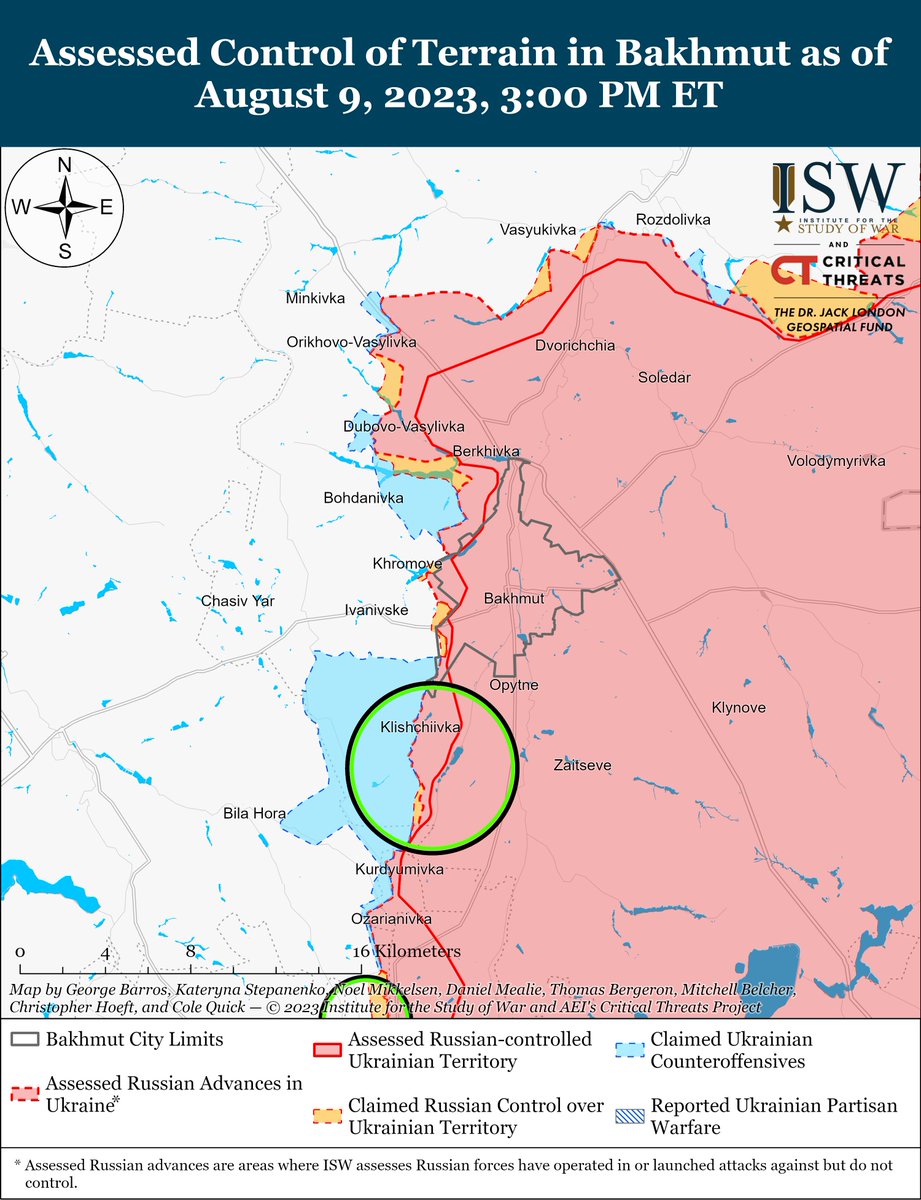
Vremivka
Vremivka is a town at the tip of the salient west of Velyka Novosiika. It was sort of the stonewall on Cemetery Ridge for Russia’s winter campaign in Donbas.
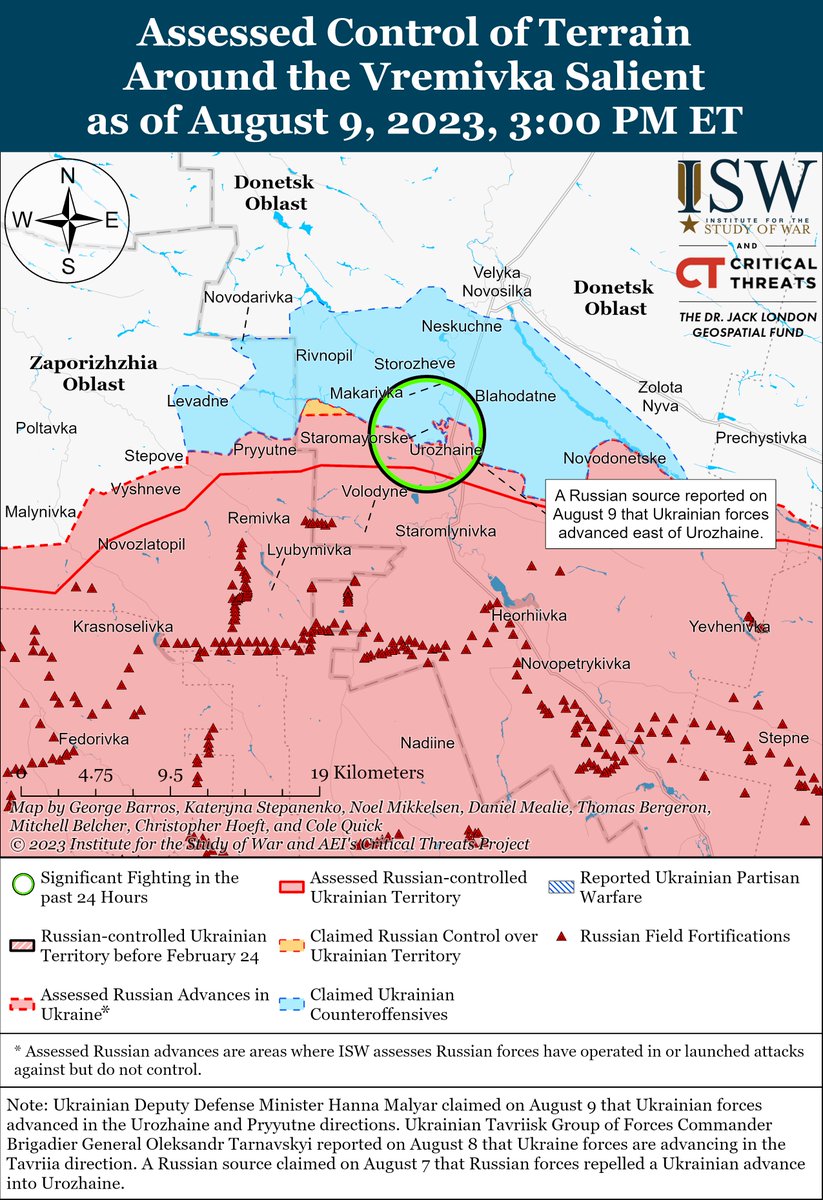
The Ukrainian Army has a slow-moving offensive in the area that has been successful and under the radar. That may be about to change. When Staromayorske fell (see inside the green circle), the Russians elected to continue defending Urozhanine instead of pulling back. This has resulted in an isolated pocket that will be rolled up in the next week. Unless managed well, that will be catastrophic for the Russians in that area. One doesn’t know if this results from misfortune, stupidity, or if it is some modern version of Stalin’s Order 227. If the latter, any significant breach in Russian fortifications will be complicated for the Russians to manage.
Southern Front
Zaporizhzhia
The main action in the war continues to be around Robotyne. Every indication is that this will be the site of Ukraine’s main effort. The Ukrainians have pushed through the first line of obstacles east of Robotyne. However, as I discussed above, the effort is increasingly one of dismounted infantry supported by engineers and artillery. The density of the minefields and the Russian ability to block cleared lanes by artillery-delivered mines has made this slow going for tanks and infantry fighting vehicles.
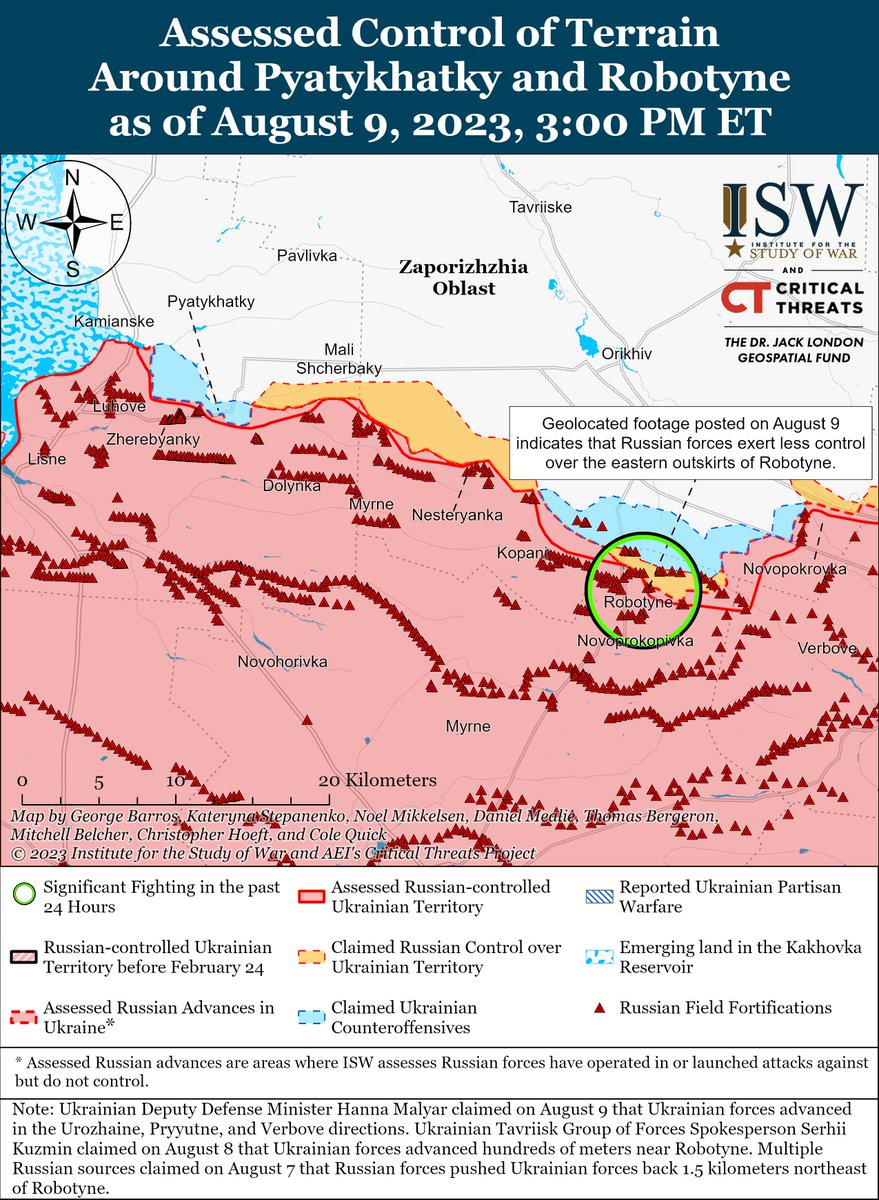
Kherson
Bridgehead Expands
A few updates ago, I posted on a small-scale bridgehead established by the Ukrainians on the left bank of the Dnieper River near the ruined Antonovsky Bridge. (see Putin’s War, Week 70. The Reckoning for the Wagner Revolt Continues)
That modest beginning has started to expand. The expansion is due to two major factors. First, it was difficult for the Russians to move troops to attack the bridgehead because of the distance through open terrain they’d have to travel while under artillery fire. Second, the experienced paratroopers who had made up the Russian reserve force in this area have been moved east to face the main Ukrainian offensive.
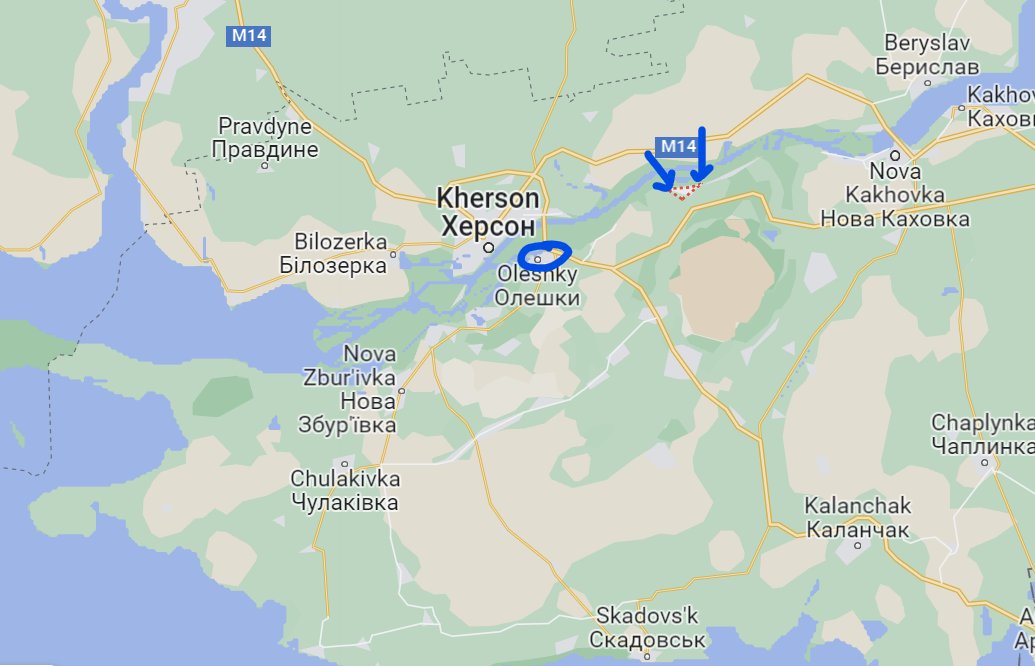
Is this operation a diversion to freeze Russian troops in place so they can’t add their weight to the defensive line in Zaporizhzhia? Is it a springboard to something larger such as a secondary axis of attack when the Ukrainian Army fights its way through Russia’s entrenchments outside Tokmak? Or is it setting the stage to become the primary axis of attack? Your guess is probably as good as mine.
Rear Areas
Crimea
Interdiction of Crimea Continues
The strategic element in Ukraine’s campaign is a mostly successful interdiction operation focused on cutting Occupied Kherson and Crimea off from lines of communication. This map shows the bridges Storm Shadow and SCALP EG attacks have put out of action.
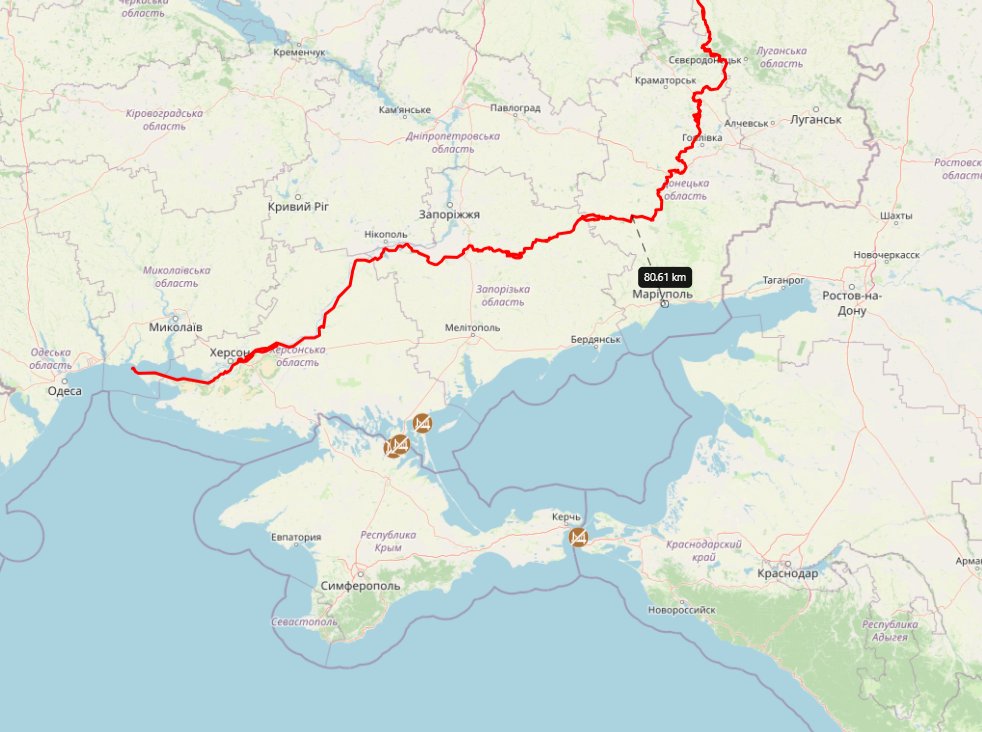
Road and rail traffic continues on the Kerch Strait Bridge but at significantly reduced rates. The main routes from Crimea to Donbas are blocked. The last shoe to drop was the Henichesk bridge that crosses from Crimea into Occupied Kherson.
/2. Something on fire in the area of one of the bridges connecting Arabat Spit with Kherson region. However not yet confirmed if specifically the bridges were targeted.
~ fire location (46.1473557, 34.8082146) pic.twitter.com/fhwWIDnF8Z— Special Kherson Cat 🐈🇺🇦 (@bayraktar_1love) August 6, 2023
You can see the ongoing, repeated strikes on GLOCs' & key logistic depos/ammo dumps across Crimea pic.twitter.com/No4nV3m1uO
— Dominic Oldridge (@OldridgeDominic) August 6, 2023
If you are looking for an analog to this campaign, look at the campaign to regain control of the right bank of the Dneiper last fall. The Ukrainians cut all bridges over the Dneiper and forced the Russians to withdraw for lack of supplies.
Partisan Activity
This kind of activity has much more psychological than military significance.
📸Partisans "lit up" the railway echelon of the occupiers in Sevastopol
At the "Simferopol Vantazhny" railway station, the participants of the "Atesh" partisan movement noticed a railway echelon of the occupiers heading north.
The warehouse transports the Tunguska… pic.twitter.com/rrTUbu2CaG
— Lew Anno Suport #Ukraine 24/2-22 (@anno1540) August 4, 2023
What’s Next?
I don’t see the Ukrainian Army reaching that “out of airspeed, out of altitude, out of ideas” point that was really obvious in Russian operations when they reached their culmination point in March 2022; see Russia’s Invasion of Ukraine Reaches Its Culmination Point and Zelensky Plays Hardball in the Peace Negotiations. Operations are slow, but the cause is not a lack of supplies; it is the insane use of mines by the Russians. As an aside, when you’re using the volume of mines the Russians are, it shows that they have no plans to counterattack in that area because they’d be caught in their minefields.
The hope for a Third Army-style ramble to the sea is probably past, but I think the measured, careful light infantry advance in the southern area will carry the day.
Reports that there has been a decrease in artillery support around Bakhmut and the willingness to give ground near Kupiansk could be significant. It is a sign that the Ukrainian high command is not trying to fight everywhere and that the resources that could make life easier on the troops in those two areas are needed elsewhere.


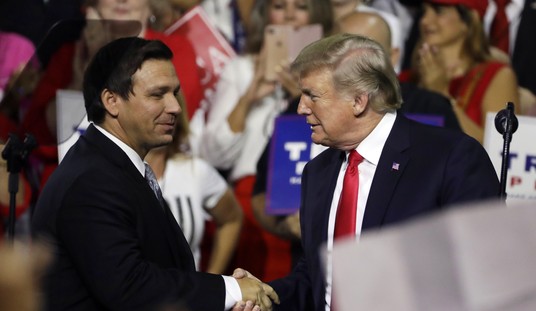






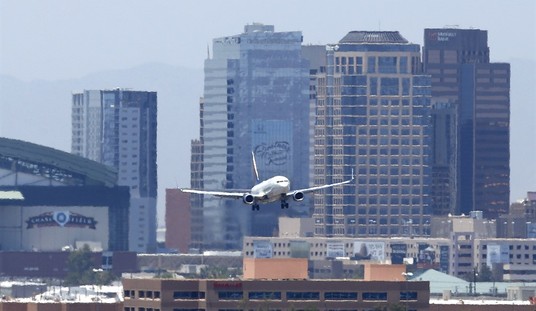

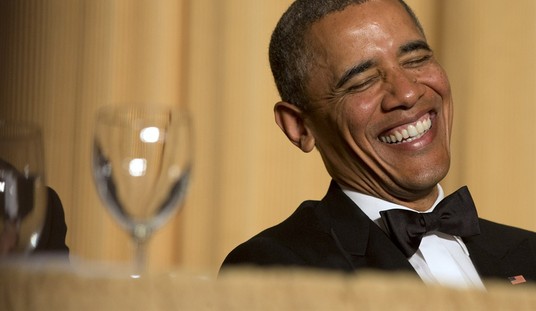
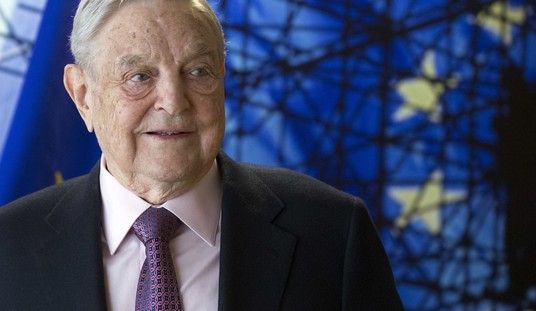

Join the conversation as a VIP Member